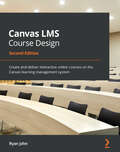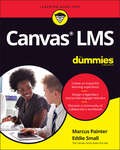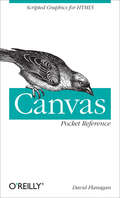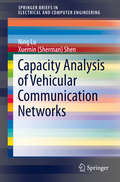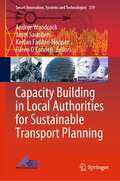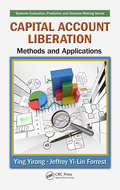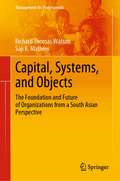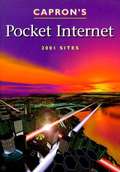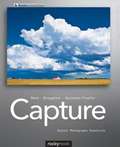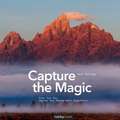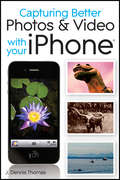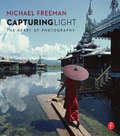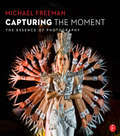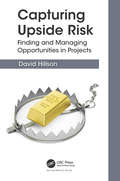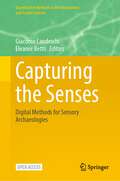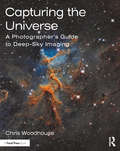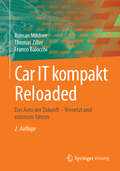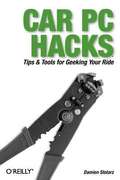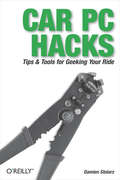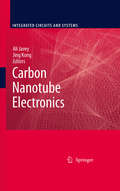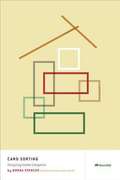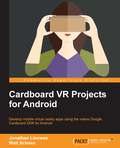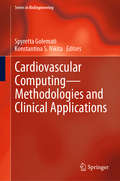- Table View
- List View
Canvas LMS Course Design: Create and deliver interactive online courses on the Canvas learning management system, 2nd Edition
by Ryan JohnA simple, easy-to-follow guide to learning the advanced features and integrated services of Canvas for creating a transformative and personalized educational experienceKey FeaturesSimplify online and hybrid learning with Canvas with the help of this updated second editionDiscover best practices to engage with students as they complete assignments and receive feedback through the GradebookFollow clear directions to use Canvas tools and features for your educational requirementsBook DescriptionCanvas is an online learning management system (LMS) and one of the most powerful teaching tools that educational institutions worldwide have adopted thanks to its streamlined functionality, intuitive user interface, and robust features. This revised second edition of Canvas LMS Course Design will show you how to design, create, and teach engaging classes in online, hybrid, or fusion settings using the Canvas LMS. The book will guide you through the steps of setting up your Canvas account, creating activities and assignments, designing and customizing the course layout, and teaching your course. Whether you're using an institutional or Free-for-Teacher account, you'll be able to use Canvas for grading, feedback, and communication with and between students. As you progress, you'll learn how to integrate external apps and services with Canvas. Finally, the book features an exclusive section detailing how you can use Canvas' built-in resources as well as other resources to tackle challenges while working with the LMS. Throughout, this book will give you the technical knowledge you need to create unique learning experiences for students. By the end of this Canvas LMS Course Design, you'll be able to successfully teach online with the help of logical descriptions and step-by-step screenshots that clearly explain how to build a phenomenal course. What you will learnUnderstand online learning as a powerful and unique tool for student growthCreate, access, and personalize your user account and profile settings in CanvasGenerate, upload, and import course content for students to engage with as participants in your coursesDesign and sequence the content of your course to present information and activities with clarity and simplicityDiscover expert techniques for designing a curriculum and creating activitiesExplore Canvas features that meet your educational needs, such as online assessments and content deliveryWho this book is forThis book is for educators who want to use Canvas to deliver instructions in online, hybrid, or fusion teaching models. Whether you're new to online learning or a seasoned expert, you will be able to learn both the primary functions and the advanced features of Canvas with this book. As a minimum, beginner-level experience with online learning is required given the widespread implementation of distance learning due to the pandemic.
Canvas LMS For Dummies
by Marcus Painter Eddie SmallMake digital learning effortless with Canvas The potential of digital learning is limitless. But implementing it in the real-world can sometimes be a challenge, especially when you have to learn the ins and outs of a new platform. So, why not choose a learning management system (LMS) that actually makes your life, and the lives of your students, easier? In Canvas For Dummies, a team of expert digital educators walks you through every important aspect of the hugely popular Canvas LMS. Written specifically for busy teachers hoping to make the most of the tools at their disposal, the book offers step-by-step instructions to design, build, and integrate a fully functional Canvas environment. From creating your first classroom home page to taking advantage of Canvas modules, you’ll learn how to use the platform to engage your students and improve their learning. Full of practical guidance and useful tips, this “how-to” handbook helps you: Navigate the creation of a blended learning environment and take advantage of the benefits of both in-person and online learning Manage collaborative environments and leverage Canvas modules to deliver a superior learning experience Integrate your Canvas modules with pre-existing, in-person material to create an intuitive environment This book is an absolute necessity for any educator or parent hoping to improve student outcomes with the powerful tools included in the Canvas LMS.
Canvas Pocket Reference: Scripted Graphics for HTML5
by David FlanaganThe Canvas element is a revolutionary feature of HTML5 that enables powerful graphics for rich Internet applications, and this pocket reference provides the essentials you need to put this element to work. If you have working knowledge of JavaScript, this book will help you create detailed, interactive, and animated graphics -- from charts to animations to video games -- whether you're a web designer or a programmer interested in graphics.Canvas Pocket Reference provides both a tutorial that covers all of the element's features with plenty of examples and a definitive reference to each of the Canvas-related classes, methods, and properties.You'll learn how to:Draw lines, polygons, and curvesApply colors, gradients, patterns, and transparencyUse transformations to smoothly rotate and resize drawingsWork with text in a graphic environmentApply shadows to create a sense of depthIncorporate bitmapped images into vector graphicsPerform image processing operations in JavaScript
Capacity Analysis of Vehicular Communication Networks (SpringerBriefs in Electrical and Computer Engineering)
by Ning Lu Xuemin Sherman ShenThis SpringerBrief focuses on the network capacity analysis of VANETs, a key topic as fundamental guidance on design and deployment of VANETs is very limited. Moreover, unique characteristics of VANETs impose distinguished challenges on such an investigation. This SpringerBrief first introduces capacity scaling laws for wireless networks and briefly reviews the prior arts in deriving the capacity of VANETs. It then studies the unicast capacity considering the socialized mobility model of VANETs. With vehicles communicating based on a two-hop relaying scheme, the unicast capacity bound is derived and can be applied to predict the throughput of real-world scenarios of VANETs. The downlink capacity of VANETs is also investigated in which access infrastructure is deployed to provide pervasive Internet access to vehicles. Different alternatives of wireless access infrastructure are considered. A lower bound of downlink capacity is derived for each type of access infrastructure. The last section of this book presents a case study based on a perfect city grid to examine the capacity-cost trade-offs of different deployments since the deployment costs of different access infrastructure are highly variable.
Capacity Building in Local Authorities for Sustainable Transport Planning (Smart Innovation, Systems and Technologies #319)
by Andree Woodcock Janet Saunders Keelan Fadden-Hopper Eileen O’ConnellThis book is conceptualized as being of interest to researchers in the field of sustainable transport, and also those who are working in the field. In the first case it will provide a reference on the state of the art of sustainable transport, and will also include insights into an EU project, how to go about delivering impact, how such projects effect local authorities, etc. Sustainable transport is an extreme growth area; it is highly innovative, with multi-million-pound investments transforming cities. The book will help and encourage resource poor small to medium local authorities catch up and meet their sustainability targets.
Capital Account Liberation: Methods and Applications (Systems Evaluation, Prediction, and Decision-Making)
by Ying Yirong Jeffrey Yi-Lin ForrestAlong with the development of economic globalization, many countries have begun to relax their controls on their capital accounts. However, the recent financial crises in Latin American countries as well as the exchange rate crises in Southeast Asian countries have shown that there is major risk associated with capital account liberalization.This b
Capital, Systems, and Objects: The Foundation and Future of Organizations (Management for Professionals)
by Richard Thomas WatsonThis book provides a set of integrated frameworks—capital, systems, and objects—that transcend managerial or technology hype by focusing on the long-term fundamentals that sustain organizational success. Many organizations are currently addressing two important transformational issues: ecological sustainability and digitization. Sustainability is a goal, an end, and digitization is a process, a means to achieve a goal. This book introduces a flexible model that can be applied to current and future organizational challenges, including sustainability and digitization, because the fundamentals are constant. This book is designed to serve two purposes for the readers: first, to present three conceptual foundations for designing and operating organizations (capital, systems, and objects in Part I); and second, to provide a reference source for implementing these ideas in an organization (Parts II and III). The Part I of the book, chapters 1 through 7, sets forth the conceptual foundations. The chapters mix concepts and practical examples to give a new way of thinking about the setting in which one may work many days each year. The Part II provides details and associated examples of every one of the thirty-six forms of capital conversion. It also illustrates how the five foundational systems support capital conversion in a variety of ways. Finally, the Part III is about measuring capital and systems. The book will resonate with practitioners and students of strategy, leadership, and organizational design. It is critical reading for leaders, industry experts, and general readers who want to understand how over thousands of years the capital creation system has developed today’s world and will fashion its future.
Capital, Systems, and Objects: The Foundation and Future of Organizations from a South Asian Perspective (Management for Professionals)
by Richard Thomas Watson Saji K. MathewThis book provides a set of integrated frameworks—capital, systems, and objects—that transcend managerial or technology hype by focusing on the long-term fundamentals that sustain organizational success, and it contains cases from South East Asia to elaborate this concept. Many organizations are currently addressing two important transformational issues: ecological sustainability and digitization. Sustainability is a goal, an end, and digitization is a process, a means to achieve a goal. This book introduces a flexible model that can be applied to current and future organizational challenges, including sustainability and digitization, because the fundamentals are constant.This book is designed to serve two purposes for the readers: first, to present three conceptual foundations for designing and operating organizations (capital, systems, and objects (section 1)); and second, to provide a reference source for implementing these ideas in your organization (sections 2 and 3). The first section of the book, chapters 1 through 7, sets forth the conceptual foundations. The chapters mix concepts and practical examples to give a new way of thinking about the setting in which one may work many days each year. The second section provides details and associated examples of every one of the thirty-six forms of capital conversion. It also illustrates how the five foundational systems support capital conversion in a variety of ways. Finally, the third section is about measuring capital and systems.The book covers measurement of all types of capital and systems performance and has been written for current and future organizational leaders to change the game and play it more effectively. The book will thus resonate with students of organizational behaviour and leadership strategy, organizational leaders, industry experts, and general readers.
Capron's Pocket Internet 2001 Sites
by H. L. CapronWant to find the best sites on the Net for your topic of interest? More than 2000 carefully selected websites so start discovering!
Capture
by Glenn Rand Chris Broughton Amanda Quintenz-FiedlerIn film-based photographic education, strong programs and writings have placed great emphasis on making a negative. But to get to the negative, good exposure is required. The beginning of the photographic process significantly affects the final outcome of an image - a fact that has not changed with digital photography. Capture: Digital Photography Essentials concentrates on photography from a digital-capture workflow point of view. The text addresses both the opportunities and limitations of digital photography, and how to work with those opportunities and around the limitations. Authors Glen Rand, Chris Broughton, and Amanda Quintenz-Fiedler discuss the digital tools that allow photographers to capture, create, and maintain high-quality digital photographs. Readers will learn to maximize the potential of their images through an understanding of the core principles and more advanced aspects of the digital photographic process. Various projects that are based on tested teaching concepts for digital photography can be found throughout the text, as well as numerous images that are both inspirational and instructional. Topics include: Digital Cameras Sensors and Lenses Basic Exposure Digital Exposure Digital Capture Workflow Image Files Parametric Editing Digital Zone System HDRI Hybrid Imaging Capture Technology
Capture the Magic
by Jack DykingaThis book uses a structured approach to teach the art of creating interesting, well-composed images. It provides solutions to problems that often get in the way of producing great photographs and emphasizes the importance of training the eye to exclude the extraneous. Examples of strong images are juxtaposed against flawed images, illustrating how to create a successful composition. Topics covered include light and shadow, lens choice, framing, negative space, and many more. In this book, author Jack Dykinga encourages us to look at photography as a way to communicate. Dykinga says, "Photography is a marvelous language that crosses linguistic borders as a universal, powerful, and direct communication. As photographers, we see something we find interesting and simply want to share it." Readers will learn new ways to create interesting and powerful compositions that communicate their intended messages. Filled with beautiful color images throughout, the book is sure to inspire, teach, and motivate photographers of all levels.
Capturing Better Photos & Videos with Your iPhone
by J. Dennis ThomasOffers unique advice for taking great photos and videos with your iPod or iPhone! Packed with unique advice, tips, and tricks, this one-of-a-kind, full-color reference presents step-by-step guidance for taking the best possible quality photos and videos using your iPod or iPhone. Top This unique book walks you through everything from composing a picture, making minor edits, and posting content to using apps to create more dynamic images. You'll quickly put to use this up-to-date coverage of executing both common and uncommon photo and video tasks on your mobile device. Presents unique advice for capturing the best possible photos and videos with your iPod or iPhone Shares tips, tricks, and techniques on everything from composing a photo, making edits, posting content, and using applications Full color throughout, Capturing Better Photos and Video with Your iPod or iPhone gets you well on your way to making the most of your mobile device's photo and video capabilities.
Capturing Light: The Heart of Photography
by Michael FreemanIn almost all photography it’s the quality of light that makes or breaks the shot. For professional photographers, chasing the light, waiting for it, sometimes helping it, and finally capturing it is a constant preoccupation — and for some an obsession. Drawing on four decades of doing just this, Michael Freeman takes a simple but practical approach to reacting to, and capturing photography’s most important commodity. There are just three sections titled Waiting, Chasing, and Helping: Waiting explains the kinds of lighting that photographers can anticipate and plan for, while Chasing explores the transient, serendipitous light that photographers have to work quickly to exploit. Helping, the final and most technical section, focuses on the skills and techniques for enhancing, reducing, or otherwise controlling light, covering everything from in-the-field shooting choices to technical transformations to post-production.
Capturing The Moment: The Essence of Photography
by Michael FreemanThis is not a book about the fundamentals of shutter speed or how your camera works; it is a book that will teach photographers of all levels how to work with their cameras to capture moments whether they are occurring quickly or unfolding over many hours. Capturing the Moment is about a gesture, an expression, a ball in the net, a whale breaching, like Marilyn Monroe’s skirt flying up or Alfred Eisenstaedt’s image of a kiss between a soldier and nurse in Times Square. Moments in all forms are the true core of photography, and this book will explain how to anticipate them, recognise them, choose them, and capture them, through the eyes and wisdom of award-winning photographer and celebrated author Michael Freeman.
Capturing Upside Risk: Finding and Managing Opportunities in Projects
by David HillsonWith more than three decades of experience as a thought-leader and expert practitioner, PMI Fellow Dr. David Hillson shares practical insight into how upside risks can be identified, assessed, and managed as opportunities. After reviewing the benefits of identifying opportunities, the book steps through the opportunity identification and management process in detail, describing proven tools and techniques as well as specific tips to make them work in practice. The book places opportunity management in the context of traditional risk management, providing a familiar pathway that leads project managers to discover new benefits and successes. David Hillson is one of the foremost authorities on risk management. With his latest book he presents a strong case for managing opportunities. As with all of David’s books, the style of writing is engaging and easy to understand. There are many nuggets of wisdom in this book, as well as a hands-on approach to leveraging opportunity management as a way of improving project performance. — Cyndi Snyder Dionisio, PMI Fellow, Coronado CA, USA. (Chair of the PMBOK® Guide, Sixth Edition) I enjoyed reading this book, which is precise, clear, logical, and persuasive. The clarity of thought and expression explains why David is such a sought-after speaker. This book is a must-read for project risk practitioners, as well as for project professionals who are serious about addressing all the risks on their project, including the good ones. — Dr Dale Cooper, Cammeray NSW, Australia. (Director, Broadleaf Capital International) At last, a clear and valuable book linking both sides of the coin in risk management: threats and opportunities. David Hillson truly engages the reader on how to deal with these two types of risk in projects, sharing his wisdom and extensive experience in creating value from risk management. Anyone who has to manage risk in real-world projects should read this book to enhance their opportunity management skills. — Professor Salim Al-Harthi, Muscat, Oman. (Director of Risk Management Office, Sultan Qaboos University) It is vital for value creation in business and in life that we consider uncertainties that would have upside impacts on our objectives (opportunities), as well as downside impacts (threats). Business gets confused between opportunities where there is a binary choice to take or not, and true uncertain opportunities that can be seized, or left to chance. David has persevered in helping us understand this and this important book is a must-read for all leaders who want to create value through the proactive management of risk. — Dr Ruth Murray-Webster, Wakefield, UK. (Partner, Beyond the Deal LLP and Editor, APM Body of Knowledge, 7th Edition) As project managers, we always seem to focus on threats, negative risks. David Hillson, one of the foremost thought-leaders on risk management, explains approaches to identify and manage opportunities, positive risks and how this will help achieve project success. As with his previous books, David provides a structured approach with examples, tools, and techniques. An excellent resource for all project managers in today’s world. — Peter Monkhouse, Toronto ON, Canada. (Past Chair PMI Board of Directors)
Capturing the Senses: Digital Methods for Sensory Archaeologies (Quantitative Methods in the Humanities and Social Sciences)
by Eleanor Betts Giacomo LandeschiThis open-access book surveys how digital technology can contribute effectively to improving our understanding of the past, through a sensory engagement based on the evidence of material culture. In particular, it encourages specialists to consider senses and human agency as important factors in studying ancient space, while recognising the role played by digital tools in enhancing a human-centred form of analysis. Significant advances in archaeological computing, digital methods, and sensory approaches have led archaeologists to rethink strategies and methods for creating narratives of the past. Recent progress in data visualisation and implementation, as well as other nascent digital sensory methods, means that it is now easier to explore and experience ancient space from a multiscalar perspective, from the individual body or single building to the wider landscape.The chapters in Capturing the Senses: Digital Methods for Sensory Archaeologies present innovative methods for representing an embodied experience of ancient space, simulating (but not recreating) ancient behaviours and social interaction. Chapters cover topics including the potentials and pitfalls of visualising, recreating, and re-enacting/experiencing the senses in Virtual Reality environments and also digital reconstructions and auralisations of ancient spaces to study sound sensory perception. Overall, the book demonstrates that multisensory approaches can give a new perspective on how ancient spaces were intended to be used by inhabitants to fulfil a series of purposes including conveying messages and regulating movement. This is an open-access book.
Capturing the Universe: A Photographer’s Guide to Deep-Sky Imaging
by Chris WoodhouseThis book provides a thorough introduction to and exploration of deep sky astrophotography for the digital photographer. With over 280 images, graphs, and tables, this introductory book uses a progressive and practical style to teach readers how to image the night sky using existing, affordable equipment. The book opens with a brief astronomy primer, followed by chapters that build progressively to explain the challenges, offer solutions, and provide invaluable information on equipment choice through image capture, calibration, and processing in affordable software. The book’s focus ranges from how to image sweeping vistas and star trails using only a camera body, lens and tripod, to more advanced methods suitable for imaging galaxies, clusters, nebulae, and stars. Other features of the book include: Real-world assignments showing how and when to use certain tools and how to overcome challenges and setbacks Practical construction projects Evaluations of the most recent developments in affordable hardware and software Exploration on how sensor performance and light pollution relate to image quality and exposure planning Ground-breaking practical chapters on lucky imaging and choosing and using the latest CMOS cameras Written in an accessible, easy to follow format, this comprehensive guide equips readers with all the necessary skills to progress from photographer to astrophotographer.
Car IT kompakt Reloaded: Das Auto der Zukunft – Vernetzt und autonom fahren
by Roman Mildner Thomas Ziller Franco BaiocchiDie vielen neuen Funktionen, die im vernetzten Auto Realität werden, finden Sie in diesem Buch übersichtlich beschrieben. Dabei geht es von der Einbindung von Google und Facebook bis hin zu Diensten, die Ihnen helfen Ihren Parkplatz wiederzufinden, per App Ihr Auto einzuparken oder das Sonnendach aus der Ferne zu schließen, wenn es regnet. Als Ziel dieser Entwicklung wird das autonome Fahren definiert inklusive aktueller Entwicklungen, Implementierungsvarianten und den wesentlichen Herausforderungen bezüglich der Sicherheit und Rechtslage. Das Buch gibt darüber hinaus Auskunft zu notwendigen Qualitätsstandards in der Entwicklung komplexer Fahrzeug-IT-Systeme. Zum Abschluss werden die Auswirkungen auf Wirtschaft, Gesellschaft und Politik beschrieben. Dabei werden speziell Fahrzeugnutzer sowie Fahrzeughersteller und ihre Lieferanten berücksichtigt.
Car PC Hacks
by Damien StolarzA car PC or carputer is a car tricked-out with electronics for playing radio, music and DVD movies, connecting to the Internet, navigating and tracking with satellite, taking photos, and any electronic gadget a person wants in a car. All these devices are managed and controlled through a single screen or interface. The only place car PC enthusiasts can go for advice, tips and tools is a handful of hard-to-find Web sites--until now. Car PC Hacks is your guide into the car PC revolution. Packing MP3 players, handheld devices, computers and video-on-demand systems gives you a pile too heavy to carry. But add a car and put them together, you've got a powerful and mobile multimedia center requiring no lifting. The next time you give kids a lift, you won't hear, "Are we there yet?" Instead, expect "We're there already?" as they won't want to leave the car while playing video games from multiple consoles. Car PC Hacks is the first book available to introduce and entrench you into this hot new market. You can count on the book because it hails from O'Reilly, a trusted resource for technical books. Expect innovation, useful tools, and fun experiments that you've come to expect from O'Reilly's Hacks Series. Maybe you've hacked computers and gadgets, and now you're ready to take it to your car. If hacking is new and you would like to mix cars and computers, this book gets you started with its introduction to the basics of car electrical systems. Even when you're unclear on the difference between amps and watts, expect a clear explanation along with real-life examples to get on track. Whether you're venturing into car PC for the first time or an experienced hobbyist, hop in the book for a joy ride.
Car PC Hacks: Tips & Tools for Geeking Your Ride
by Damien StolarzA car PC or carputer is a car tricked-out with electronics for playing radio, music and DVD movies, connecting to the Internet, navigating and tracking with satellite, taking photos, and any electronic gadget a person wants in a car. All these devices are managed and controlled through a single screen or interface. The only place car PC enthusiasts can go for advice, tips and tools is a handful of hard-to-find Web sites--until now. Car PC Hacks is your guide into the car PC revolution.Packing MP3 players, handheld devices, computers and video-on-demand systems gives you a pile too heavy to carry. But add a car and put them together, you've got a powerful and mobile multimedia center requiring no lifting. The next time you give kids a lift, you won't hear, "Are we there yet?" Instead, expect "We're there already?" as they won't want to leave the car while playing video games from multiple consoles.Car PC Hacks is the first book available to introduce and entrench you into this hot new market. You can count on the book because it hails from O'Reilly, a trusted resource for technical books. Expect innovation, useful tools, and fun experiments that you've come to expect from O'Reilly's Hacks Series.Maybe you've hacked computers and gadgets, and now you're ready to take it to your car. If hacking is new and you would like to mix cars and computers, this book gets you started with its introduction to the basics of car electrical systems. Even when you're unclear on the difference between amps and watts, expect a clear explanation along with real-life examples to get on track. Whether you're venturing into car PC for the first time or an experienced hobbyist, hop in the book for a joy ride.
Carbon Nanotube Electronics (Integrated Circuits and Systems)
by Ali Javey Jing KongThis book provides a complete overview of the field of carbon nanotube electronics. It covers materials and physical properties, synthesis and fabrication processes, devices and circuits, modeling, and finally novel applications of nanotube-based electronics. The book introduces fundamental device physics and circuit concepts of 1-D electronics. At the same time it provides specific examples of the state-of-the-art nanotube devices.
Card Sorting
by Donna SpencerCard sorting helps us understand how people think about content and categories. Armed with this knowledge, we can group information so that people can better find and understand it. In this book, Donna describes how to plan and run a card sort, then analyse the results and apply the outcomes to your project.
Cardboard VR Projects for Android
by Jonathan Linowes Matt SchoenDevelop mobile virtual reality apps using the native Google Cardboard SDK for Android About This Book * Learn how to build practical applications for Google's popular DIY VR headset * Build a reusable VR graphics engine on top of the Cardboard Java SDK and OpenGL ES graphics libraries * The projects in this book will showcase a different aspect of Cardboard development--from 3D rendering to handling user input Who This Book Is For The book is for established Android developers with a good knowledge level of Java. No prior OpenGL or graphics knowledge is required. No prior experience with Google Cardboard is expected, but those who are familiar with Cardboard and are looking for projects to expand their knowledge can also benefit from this book. What You Will Learn * Build Google Cardboard virtual reality applications * Explore the ins and outs of the Cardboard SDK Java classes and interfaces, and apply them to practical VR projects * Employ Android Studio, Android SDK, and the Java language in a straightforward manner * Discover and use software development and Android best practices for mobile and Cardboard applications, including considerations for memory management and battery life * Implement user interface techniques for menus and gaze-based selection within VR * Utilize the science, psychology, mathematics, and technology behind virtual reality, especially those pertinent to mobile Cardboard VR experiences * Understand Cardboard VR best practices including those promoted by Google Design Lab. In Detail Google Cardboard is a low-cost, entry-level media platform through which you can experience virtual reality and virtual 3D environments. Its applications are as broad and varied as mobile smartphone applications themselves. This book will educate you on the best practices and methodology needed to build effective, stable, and performant mobile VR applications. In this book, we begin by defining virtual reality (VR) and how Google Cardboard fits into the larger VR and Android ecosystem. We introduce the underlying scientific and technical principles behind VR, including geometry, optics, rendering, and mobile software architecture. We start with a simple example app that ensures your environment is properly set up to write, build, and run the app. Then we develop a reusable VR graphics engine that you can build upon. And from then on, each chapter is a self-contained project where you will build an example from a different genre of application, including a 360 degree photo viewer, an educational simulation of our solar system, a 3D model viewer, and a music visualizer. Style and approach This project based guide is written in a tutorial-style project format, where you will learn by doing. It is accompanied by in-depth explanations and discussions of various technologies, and provides best practices and techniques.
Cardiovascular Computing—Methodologies and Clinical Applications (Series in BioEngineering)
by Spyretta Golemati Konstantina S. NikitaThis book provides a comprehensive guide to the state-of-the-art in cardiovascular computing and highlights novel directions and challenges in this constantly evolving multidisciplinary field. The topics covered span a wide range of methods and clinical applications of cardiovascular computing, including advanced technologies for the acquisition and analysis of signals and images, cardiovascular informatics, and mathematical and computational modeling.
Career Clusters: Information Technology
by Glencoe/McGraw-HillCareer Cluster Workbooks are designed to guide students through 16 career pathways as outlined by the U. S. Department of Education. Contained in 10 workbooks, each is a complete research process that allows students to understand all of the opportunities available within each career cluster.
